
|
Bright new comet discovered in the SWAN images. It brightened rapidly up to 7.8 mag on Apr. 8 (Osamu Miyazaki). Then it has been fading before the perihelion passage. Now it is 9.1 mag (Apr. 20, Osamu Miyazaki). In the Northern Hemisphere, it will be unobservable in May. In the Southern Hemisphere, it is not observable now, but it will appear in May.
Date(TT) R.A. (2000) Decl. Delta r Elong. m1 Best Time(A, h)
Apr. 19 0 58.49 33 50.6 1.126 0.483 25 8.8 3:53 (232, 6)
Apr. 26 2 25.83 34 17.7 0.999 0.367 21 9.8 20:13 (134, -1)
|

|
It is visible at 11 mag in the SWAN images (Jan. 27, Vladimir Bezugly). It will fade out rapidly after this. Now it is not observable. It will appear in July in the Southern Hemisphere.
Date(TT) R.A. (2000) Decl. Delta r Elong. m1 Best Time(A, h)
Apr. 19 2 8.19 6 22.2 2.059 1.069 6 11.3 20:05 (111,-17)
Apr. 26 2 36.92 6 39.1 2.089 1.105 8 11.6 20:13 (113,-18)
|

|
It approached to Sun down to 0.09 a.u. on Jan. 13. It brightened up to -2 or -3 mag and it was detected even in the daylight. The nucleus was disintegrated on Jan. 19. However, its remnant is still visible. It will fade out rapidly after this. In the Northern Hemisphere, it will never be observable after this. In the Southern Hemisphere, it will be getting higher gradually.
Date(TT) R.A. (2000) Decl. Delta r Elong. m1 Best Time(A, h)
Apr. 19 1 25.32 -45 38.7 2.592 2.210 56 12.5 3:53 (303,-41)
Apr. 26 1 37.82 -46 43.0 2.642 2.321 60 12.8 3:43 (305,-41)
|

|
It brightened up to -3 mag due to the forward scattering on Oct. 9 in the SOHO coronagraph images (Q.-c. Zhang, Charles S. Morris). It became a great comet of 0 mag on the ground. Now it is 12.4 mag (Mar. 22, Ken-ichi Kadota). Fading slowly. In the Northern Hemisphere, it stays observable in good condition. It locates somewhat low in the Southern Hemisphere.
Date(TT) R.A. (2000) Decl. Delta r Elong. m1 Best Time(A, h)
Apr. 19 20 21.18 21 50.1 3.519 3.455 78 12.8 3:53 (280, 53)
Apr. 26 20 17.60 23 3.9 3.504 3.541 83 12.8 3:43 (282, 57)
|

|
It brightens up to 13 mag in early summer. But the condition in this apparition is bad. Now it is 14.4 mag (Apr. 1, Hidetaka Sato). Fading slowly. In the Northern Hemisphere, it is not observable now, but it will appear in July. It stays extremely low in the Southern Hemisphere. But it will become high in autumn.
Date(TT) R.A. (2000) Decl. Delta r Elong. m1 Best Time(A, h)
Apr. 19 0 9.78 -3 52.0 2.102 1.310 28 13.9 3:53 (269, -8)
Apr. 26 0 35.06 -1 48.9 2.068 1.281 28 13.7 3:43 (266, -8)
|
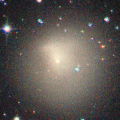
|
Now it is 11.1 mag (Apr. 3, Thomas Lehmann). It will be getting lower gradually after this, and it will be unobservable in July in the Northern Hemisphere, or in August in the Southern Hemisphere.
Date(TT) R.A. (2000) Decl. Delta r Elong. m1 Best Time(A, h)
Apr. 19 9 35.82 10 51.2 5.800 6.273 113 13.8 20:05 ( 12, 65)
Apr. 26 9 35.90 10 50.0 5.905 6.274 107 13.8 20:13 ( 30, 63)
|

|
Now it is 11.9 mag (Apr. 6, Marco Goiato). It stays 14 mag for a while. It stays observable in good condition.
Date(TT) R.A. (2000) Decl. Delta r Elong. m1 Best Time(A, h)
Apr. 19 15 28.52 -9 28.4 4.337 5.265 155 13.9 1:41 ( 0, 45)
Apr. 26 15 25.96 -8 29.9 4.318 5.282 161 13.9 1:11 ( 0, 46)
|

|
Now it is 13.7 mag (Apr. 4, Thomas Lehmann). It will fade out rapidly after this. It will be unobservable in July.
Date(TT) R.A. (2000) Decl. Delta r Elong. m1 Best Time(A, h)
Apr. 19 4 39.50 17 18.8 2.011 1.435 42 14.2 20:05 ( 98, 19)
Apr. 26 5 2.62 19 8.0 2.043 1.442 40 14.3 20:13 (102, 18)
|
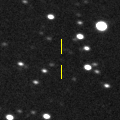
|
It stays 15 mag for a while. In the Northern Hemisphere, it is not observable now, but it will appear in June. In the Southern Hemisphere, it will be getting higher gradually.
Date(TT) R.A. (2000) Decl. Delta r Elong. m1 Best Time(A, h)
Apr. 19 0 10.48 -6 44.6 2.849 2.041 29 14.4 3:53 (271,-10)
Apr. 26 0 25.73 -5 27.1 2.825 2.052 32 14.4 3:43 (271, -9)
|

|
Now it is 14.9 mag (Feb. 4, Alfons Diepvens). It stays 14 mag for a while. Now it is not observable. It will appear in May.
Date(TT) R.A. (2000) Decl. Delta r Elong. m1 Best Time(A, h)
Apr. 19 1 3.04 10 41.0 4.914 3.933 10 14.4 3:53 (249,-10)
Apr. 26 1 11.88 11 38.8 4.881 3.919 15 14.4 3:43 (250, -8)
|
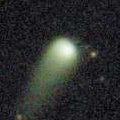
|
It was observed at 12-13 mag for a long time in 2024. Now it is 14.5 mag (Apr. 3, Thomas Lehmann). It stays 15 mag for a while. It locates somewhat low in the Northern Hemisphere. But it will become high in summer. In the Southern Hemisphere, it is not observable now.
Date(TT) R.A. (2000) Decl. Delta r Elong. m1 Best Time(A, h)
Apr. 19 1 40.89 48 0.1 4.900 4.142 36 14.4 3:53 (216, 9)
Apr. 26 1 43.50 48 10.9 4.951 4.171 35 14.5 3:43 (217, 11)
|

|
Now it is 14.9 mag (Mar. 22, Hiroshi Abe). It stays 15 mag for a while. It will be getting lower gradually after this, and it will be unobservable in June. But it will be observable again in August in the Northern Hemisphere.
Date(TT) R.A. (2000) Decl. Delta r Elong. m1 Best Time(A, h)
Apr. 19 6 32.29 14 43.1 5.855 5.580 69 14.8 20:05 ( 79, 40)
Apr. 26 6 36.58 15 12.2 5.945 5.570 63 14.8 20:13 ( 85, 34)
|

|
Now it is 15.0 mag (Apr. 3, Ken-ichi Kadota). Fading slowly. In the Northern Hemisphere, it will be getting lower gradually after this, and it will be unobservable in July. In the Southern Hemisphere, it stays observable in good condition.
Date(TT) R.A. (2000) Decl. Delta r Elong. m1 Best Time(A, h)
Apr. 19 12 29.60 -20 57.0 2.497 3.453 158 15.1 22:37 ( 0, 34)
Apr. 26 12 12.65 -18 32.4 2.549 3.461 150 15.1 21:53 ( 0, 37)
|

|
Brightened rapidly. Now it is 14.6 mag (Jan. 31, Thomas Lehmann). Fading slowly. In the Northern Hemisphere, it will be unobservable in May. In the Southern Hemisphere, it is not observable now, but it will appear in May.
Date(TT) R.A. (2000) Decl. Delta r Elong. m1 Best Time(A, h)
Apr. 19 0 29.98 17 19.0 2.765 1.851 19 15.1 3:53 (249, 0)
Apr. 26 0 44.10 16 16.4 2.768 1.871 21 15.1 3:43 (250, 0)
|

|
It brightened up to 12.7 mag in 2024 summer (Aug. 7, 2024, Thomas Lehmann). Now it is 14.9 mag (Apr. 7, Masayoshi Yoshimi). It stays 16 mag for a while. In the Northern Hemisphere, it will be getting higher gradually. In the Southern Hemisphere, it will be unobservable in August.
Date(TT) R.A. (2000) Decl. Delta r Elong. m1 Best Time(A, h)
Apr. 19 22 46.23 21 51.2 3.532 2.903 44 15.2 3:53 (259, 23)
Apr. 26 22 54.11 24 12.7 3.521 2.947 48 15.2 3:43 (258, 26)
|

|
Now it is 14.9 mag (Apr. 2, Thomas Lehmann). Fading slowly. In the Northern Hemisphere, it will be getting lower gradually after this, and it will be unobservable in July. In the Southern Hemisphere, it stays observable in good condition.
Date(TT) R.A. (2000) Decl. Delta r Elong. m1 Best Time(A, h)
Apr. 19 8 45.81 15 13.0 2.259 2.640 100 15.2 20:05 ( 42, 65)
Apr. 26 8 51.55 14 36.3 2.350 2.645 95 15.3 20:13 ( 53, 60)
|
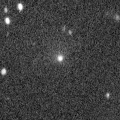
|
Very large comet. It is expected to brighten up to 13 mag in 2031. Now it is 15.3 mag (Apr. 4, ATLAS South Africa). It stays 15 mag for a while. In the Northern Hemisphere, it is not observable now. In the Northern Hemisphere, it is not observable until 2030.
Date(TT) R.A. (2000) Decl. Delta r Elong. m1 Best Time(A, h)
Apr. 19 3 59.72 -65 46.9 15.359 15.228 80 15.3 20:05 ( 29,-31)
Apr. 26 4 4.40 -65 37.4 15.318 15.205 81 15.2 20:13 ( 30,-34)
|

|
Now it is 15.4 mag (Apr. 7, Ken-ichi Kadota). Fading slowly. It locates somewhat low in the Northern Hemisphere. In the Southern Hemisphere, it stays observable in good condition.
Date(TT) R.A. (2000) Decl. Delta r Elong. m1 Best Time(A, h)
Apr. 19 13 11.08 -32 57.5 2.685 3.629 156 15.4 23:20 ( 0, 22)
Apr. 26 13 9.11 -31 56.8 2.699 3.643 156 15.5 22:51 ( 0, 23)
|

|
Now it is 16.1 mag (Mar. 27, Thomas Lehmann). It stays 15 mag for a while. It will be unobservable in May. But it will be observable again in August.
Date(TT) R.A. (2000) Decl. Delta r Elong. m1 Best Time(A, h)
Apr. 19 4 3.98 19 18.5 3.335 2.563 33 15.5 20:05 (105, 13)
Apr. 26 4 17.16 19 40.0 3.367 2.549 30 15.5 20:13 (108, 9)
|

|
First return of a new periodic comet which brightened up to 15 mag in 2010. Now it is 14.3 mag (Mar. 29, Thomas Lehmann). It will fade out rapidly after this. It will be fainter than 18 mag in July. In the Northern Hemisphere, it will be getting lower gradually. It stays extremely low in the Southern Hemisphere.
Date(TT) R.A. (2000) Decl. Delta r Elong. m1 Best Time(A, h)
Apr. 19 6 25.37 36 0.3 1.800 1.684 67 15.5 20:05 (107, 48)
Apr. 26 6 49.68 35 46.1 1.863 1.708 65 15.6 20:13 (108, 46)
|

|
Parent asteroid of Geminids meteor shower. Now it is 15.9 mag (Jan. 12, E. Prosperi, M. Jaeger). Fading gradually. It will be fainter than 18 mag in June. Now it is not observable. It will appear in May in the Northern Hemisphere, or in June in the Southern Hemisphere.
Date(TT) R.A. (2000) Decl. Delta r Elong. m1 Best Time(A, h)
Apr. 19 0 53.25 15 45.7 1.625 0.694 13 15.6 3:53 (247, -5)
Apr. 26 1 12.71 18 39.2 1.760 0.835 15 16.1 3:43 (244, -4)
|
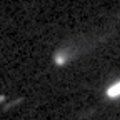
|
Now it is 16.5 mag (Mar. 26, Andrew Pearce). It stays 15 mag for a while. It locates somewhat low in the Northern Hemisphere. In the Southern Hemisphere, it stays observable in good condition.
Date(TT) R.A. (2000) Decl. Delta r Elong. m1 Best Time(A, h)
Apr. 19 18 52.23 -26 46.0 2.483 2.940 107 15.7 3:53 (342, 26)
Apr. 26 18 56.09 -27 6.5 2.392 2.937 113 15.6 3:43 (346, 26)
|

|
It is expected to brighten up to 13 mag in early summer in 2026. Now it is 16.8 mag (Jan. 30, Ken-ichi Kadota). Brightening slowly. In the Northern Hemisphere, it will be getting higher gradually. It locates somewhat low in the Southern Hemisphere. But it will become high in autumn.
Date(TT) R.A. (2000) Decl. Delta r Elong. m1 Best Time(A, h)
Apr. 19 22 35.65 19 59.8 5.414 4.783 46 16.0 3:53 (262, 24)
Apr. 26 22 35.99 20 32.3 5.293 4.744 52 15.9 3:43 (263, 28)
|

|
Now it is 16.1 mag (Mar. 31, Andrew Pearce). It stays 16 mag for a while. In the Northern Hemisphere, it will be unobservable in June. In the Southern Hemisphere, it stays observable in good condition.
Date(TT) R.A. (2000) Decl. Delta r Elong. m1 Best Time(A, h)
Apr. 19 11 17.04 -40 39.3 4.456 5.222 135 15.9 21:26 ( 0, 14)
Apr. 26 11 7.91 -39 0.9 4.503 5.228 131 16.0 20:49 ( 0, 16)
|

|
Now it is 15.8 mag (Apr. 4, Ken-ichi Kadota). It stays 16 mag for a while. In the Northern Hemisphere, it stays observable in good condition. In the Southern Hemisphere, it will never be observable after this.
Date(TT) R.A. (2000) Decl. Delta r Elong. m1 Best Time(A, h)
Apr. 19 10 57.81 65 30.0 4.112 4.354 97 15.9 21:07 (180, 60)
Apr. 26 10 50.10 65 45.2 4.187 4.346 92 16.0 20:32 (180, 59)
|

|
It will brighten up to 13 mag in 2026. Now it is 16.3 mag (Apr. 9, ATLAS Chile). It stays 16 mag for a while. In the Southern Hemisphere, it stays observable in good condition.
Date(TT) R.A. (2000) Decl. Delta r Elong. m1 Best Time(A, h)
Apr. 19 19 48.31 -22 53.6 6.062 6.214 94 16.0 3:53 (328, 25)
Apr. 26 19 48.20 -22 25.1 5.903 6.172 100 16.0 3:43 (331, 27)
|

|
It is expected to brighten up to 5 mag in 2026 January. Now it is 16.6 mag (Apr. 8, ATLAS-MLO, Mauna Loa). Brightening gradually. In the Northern Hemisphere, it stays observable in good condition. In the Southern Hemisphere, it will be unobservable in May. But it will be observable again in July.
Date(TT) R.A. (2000) Decl. Delta r Elong. m1 Best Time(A, h)
Apr. 19 18 26.71 52 8.3 4.003 4.181 93 16.2 3:53 (202, 71)
Apr. 26 18 24.25 53 20.6 3.898 4.103 94 16.1 3:43 (192, 71)
|

|
Now it is 15.8 mag (Mar. 24, Andrew Pearce). It stays 16 mag for a while. It will be getting lower gradually after this, and it will be unobservable in June. But it will be observable again in August in the Northern Hemisphere.
Date(TT) R.A. (2000) Decl. Delta r Elong. m1 Best Time(A, h)
Apr. 19 6 34.37 7 17.7 4.119 3.906 70 16.2 20:05 ( 71, 36)
Apr. 26 6 37.14 8 50.0 4.222 3.899 64 16.3 20:13 ( 79, 31)
|

|
Now it is 16.1 mag (Mar. 22, Andrew Pearce). It stays 16 mag for a while. In the Northern Hemisphere, it will be unobservable in May. In the Southern Hemisphere, it will be getting lower gradually. But it will be getting higher again after July.
Date(TT) R.A. (2000) Decl. Delta r Elong. m1 Best Time(A, h)
Apr. 19 6 50.90 -17 3.3 6.721 6.623 80 16.3 20:05 ( 48, 22)
Apr. 26 6 54.26 -16 10.8 6.798 6.617 75 16.4 20:13 ( 55, 18)
|

|
It brightened up to 13.8 mag in winter (Dec. 30, Thomas Lehmann). Now it is 16.4 mag (Apr. 4, Ken-ichi Kadota). Fading gradually. It will be fainter than 18 mag in July. In the Northern Hemisphere, it stays observable in good condition. It stays extremely low in the Southern Hemisphere.
Date(TT) R.A. (2000) Decl. Delta r Elong. m1 Best Time(A, h)
Apr. 19 8 34.45 50 1.9 2.810 2.967 88 16.4 20:05 (142, 69)
Apr. 26 8 43.43 47 54.3 2.919 3.004 85 16.6 20:13 (131, 67)
|
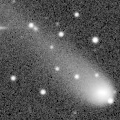
|
Now it is 16.3 mag (Mar. 27, ATLAS South Africa). It stays 17 mag for a while. In the Northern Hemisphere, it is not observable now. In the Southern Hemisphere, it will be getting lower gradually. But it will be getting higher again after June.
Date(TT) R.A. (2000) Decl. Delta r Elong. m1 Best Time(A, h)
Apr. 19 5 24.24 -39 14.8 7.480 7.218 71 16.6 20:05 ( 46, -7)
Apr. 26 5 25.67 -38 35.2 7.568 7.263 68 16.6 20:13 ( 51,-12)
|

|
It returned for the first time in 68 years. It brightened up to 6.2 mag in early last summer (July 1, Virgilio Gonano). Now it is 16.6 mag (Apr. 8, ATLAS Chile). It will fade out rapidly after this. It will be fainter than 18 mag in June. It locates somewhat low in the Northern Hemisphere. In the Southern Hemisphere, it stays observable in good condition.
Date(TT) R.A. (2000) Decl. Delta r Elong. m1 Best Time(A, h)
Apr. 19 18 46.21 -23 25.5 3.406 3.841 108 16.7 3:53 (343, 30)
Apr. 26 18 44.46 -24 2.1 3.367 3.908 115 16.8 3:43 (348, 30)
|
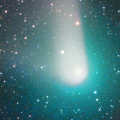
|
It brightened up to 8 mag from 2022 summer to 2023 spring. Now it is 16.1 mag (Apr. 7, Ken-ichi Kadota). It stays 17 mag for a while. It will be unobservable in May. But it will be observable again in July.
Date(TT) R.A. (2000) Decl. Delta r Elong. m1 Best Time(A, h)
Apr. 19 5 28.26 24 24.2 9.007 8.455 53 16.7 20:05 ( 99, 32)
Apr. 26 5 30.44 24 35.3 9.152 8.507 47 16.8 20:13 (103, 26)
|
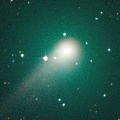
|
It was observed at 9-10 mag for a long time in 2023. Now it is 16.2 mag (Apr. 5, ATLAS South Africa). It stays 17 mag for a while. In the Northern Hemisphere, it will never be observable after this. In the Southern Hemisphere, it stays observable in good condition.
Date(TT) R.A. (2000) Decl. Delta r Elong. m1 Best Time(A, h)
Apr. 19 22 17.26 -63 18.1 7.225 7.198 84 16.9 3:53 (333,-22)
Apr. 26 22 18.98 -64 2.6 7.193 7.250 89 16.9 3:43 (335,-21)
|

|
Now it is 17.2 mag (Apr. 7, E. Cortes, B. Lutkenhoner). Brightening slowly. It locates somewhat low in the Northern Hemisphere. But it will become high in summer. In the Southern Hemisphere, it stays observable in good condition.
Date(TT) R.A. (2000) Decl. Delta r Elong. m1 Best Time(A, h)
Apr. 19 22 15.21 -19 46.3 3.375 3.012 60 17.0 3:53 (298, 5)
Apr. 26 22 24.23 -18 55.6 3.280 2.998 65 16.9 3:43 (299, 7)
|
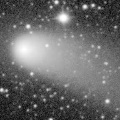
|
It brightened up to 9.6 mag from February to March in 2024 (Feb. 25, 2024, Thomas Lehmann). Now it is 16.7 mag (Mar. 22, Ken-ichi Kadota). It stays 17 mag for a while. In the Northern Hemisphere, it will be getting higher gradually. In the Southern Hemisphere, it is not observable now, but it will be observable soon.
Date(TT) R.A. (2000) Decl. Delta r Elong. m1 Best Time(A, h)
Apr. 19 23 14.49 36 6.4 5.952 5.256 42 16.9 3:53 (242, 25)
Apr. 26 23 19.62 36 47.2 5.981 5.320 45 17.0 3:43 (242, 27)
|
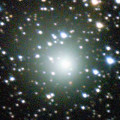
|
It brightened up to 8.3 mag in 2021-2022 winter (Jan. 6, 2022, Toshiyuki Takahashi). Now it is 18.8 mag (Mar. 26, ATLAS Chile). It stays 17 mag for a while. In the Northern Hemisphere, it will never be observable after this. In the Southern Hemisphere, it stays observable in good condition.
Date(TT) R.A. (2000) Decl. Delta r Elong. m1 Best Time(A, h)
Apr. 19 12 1.42 -59 32.1 9.398 10.043 127 17.0 22:10 ( 0, -5)
Apr. 26 11 58.35 -59 9.9 9.437 10.086 127 17.0 21:40 ( 0, -4)
|
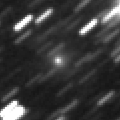
|
Very far object. Now it is 16.9 mag (Dec. 20, ATLAS Chile). It stays 17 mag for a while. In the Northern Hemisphere, it is not observable now. In the Southern Hemisphere, it will be getting higher gradually.
Date(TT) R.A. (2000) Decl. Delta r Elong. m1 Best Time(A, h)
Apr. 19 1 13.68 -53 41.6 11.063 10.680 65 17.0 3:53 (314,-41)
Apr. 26 1 16.43 -53 28.7 11.026 10.690 67 17.0 3:43 (314,-39)
|
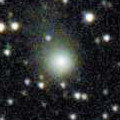
|
It brightened up to 12.1 mag in 2023 spring (May 20, 2023, Jose Guilherme de S. Aguiar). Now it is 17.4 mag (Mar. 25, ATLAS South Africa). It stays 17 mag for a while. In the Northern Hemisphere, it will be unobservable soon. But it will be observable again in August. In the Southern Hemisphere, it will be getting lower gradually. But it will be getting higher again after July.
Date(TT) R.A. (2000) Decl. Delta r Elong. m1 Best Time(A, h)
Apr. 19 5 40.84 -22 50.3 7.319 6.979 66 17.1 20:05 ( 56, 7)
Apr. 26 5 43.49 -21 58.6 7.436 7.027 62 17.1 20:13 ( 62, 1)
|

|
Now it is 17.0 mag (Apr. 7, ATLAS Chile). It stays 17 mag for a while. In the Northern Hemisphere, it will be unobservable in July. In the Southern Hemisphere, it stays observable in good condition.
Date(TT) R.A. (2000) Decl. Delta r Elong. m1 Best Time(A, h)
Apr. 19 11 24.93 -37 23.3 4.569 5.364 138 17.1 21:34 ( 0, 18)
Apr. 26 11 19.29 -35 30.1 4.600 5.360 135 17.1 21:01 ( 0, 19)
|

|
It brightened up to 15.2 mag in winter (Dec. 30, ATLAS-MLO, Mauna Loa). Now it is 16.3 mag (Apr. 3, ATLAS-HKO, Haleakala). Fading slowly. It will be fainter than 18 mag in June. In the Northern Hemisphere, it will be getting lower gradually. It locates somewhat low in the Southern Hemisphere.
Date(TT) R.A. (2000) Decl. Delta r Elong. m1 Best Time(A, h)
Apr. 19 6 41.78 12 45.5 4.085 3.891 71 17.1 20:05 ( 75, 41)
Apr. 26 6 48.39 12 51.4 4.201 3.914 66 17.2 20:13 ( 80, 35)
|

|
It brightened up to 13.1 mag in autumn (Nov. 1, Thomas Lehmann). Now it is 16.5 mag (Apr. 6, ATLAS-HKO, Haleakala). Fading gradually. It will be fainter than 18 mag in June. It stays observable in good condition.
Date(TT) R.A. (2000) Decl. Delta r Elong. m1 Best Time(A, h)
Apr. 19 17 52.94 12 53.3 2.367 2.930 114 17.1 3:53 (352, 68)
Apr. 26 17 45.89 12 24.7 2.347 2.997 121 17.2 3:31 ( 0, 67)
|

|
It returns for the first time in 70 years. It brightened up to 3.7 mag in early April in 2024 (Apr. 6, 2024, Jose Guilherme Aguiar). Now it is 17.9 mag (Mar. 14, ATLAS Chile). Fading slowly. It will be fainter than 18 mag in June. It stays extremely low in the Northern Hemisphere. In the Southern Hemisphere, it stays observable in good condition.
Date(TT) R.A. (2000) Decl. Delta r Elong. m1 Best Time(A, h)
Apr. 19 16 55.31 -51 43.3 4.098 4.738 124 17.2 3:09 ( 0, 3)
Apr. 26 16 47.61 -51 39.7 4.085 4.804 130 17.3 2:33 ( 0, 3)
|

|
Now it is 17.3 mag (Mar. 30, ATLAS South Africa). It stays 17 mag for a while. It will be unobservable in May in the Northern Hemisphere, or in July in the Southern Hemisphere. But it will be observable again in July in the Southern Hemisphere.
Date(TT) R.A. (2000) Decl. Delta r Elong. m1 Best Time(A, h)
Apr. 19 6 36.97 -5 44.8 4.639 4.468 74 17.2 20:05 ( 59, 28)
Apr. 26 6 41.79 -5 33.0 4.721 4.465 69 17.2 20:13 ( 65, 23)
|

|
It will brighten up to 9 mag in 2026 spring. Now it is 17.3 mag (Mar. 22, ATLAS-MLO, Mauna Loa). Brightening slowly. In the Northern Hemisphere, it will be getting lower gradually after this, and it will be unobservable in August. In the Southern Hemisphere, it stays observable in good condition.
Date(TT) R.A. (2000) Decl. Delta r Elong. m1 Best Time(A, h)
Apr. 19 10 19.36 15 59.9 2.531 3.178 121 17.3 20:29 ( 0, 71)
Apr. 26 10 17.67 15 56.6 2.583 3.140 114 17.2 20:13 ( 10, 71)
|

|
Now it is 17.2 mag (Mar. 31, ATLAS South Africa). It stays 18 mag for a while. It will be unobservable in May in the Northern Hemisphere, or in July in the Southern Hemisphere. But it will be observable again in August in the Southern Hemisphere.
Date(TT) R.A. (2000) Decl. Delta r Elong. m1 Best Time(A, h)
Apr. 19 7 26.83 -38 5.3 3.553 3.740 92 17.3 20:05 ( 29, 9)
Apr. 26 7 29.01 -35 8.2 3.612 3.730 88 17.3 20:13 ( 36, 8)
|

|
Peculiar asteroid moving along a cometary orbit. Now it is 17.5 mag (Feb. 24, Taras Prystavski). It stays 17 mag for a while. It will be unobservable in June in the Northern Hemisphere, or in August in the Southern Hemisphere.
Date(TT) R.A. (2000) Decl. Delta r Elong. m1 Best Time(A, h)
Apr. 19 5 25.65 -0 45.1 2.299 1.919 55 17.4 20:05 ( 76, 18)
Apr. 26 5 41.91 0 11.4 2.316 1.894 53 17.4 20:13 ( 80, 15)
|

|
Now it is 17.4 mag (Sept. 20, Taras Prystavski). It stays 17 mag for a while. In the Northern Hemisphere, it will be getting higher gradually. In the Southern Hemisphere, it stays observable in good condition.
Date(TT) R.A. (2000) Decl. Delta r Elong. m1 Best Time(A, h)
Apr. 19 21 21.11 -1 25.9 3.445 3.195 67 17.4 3:53 (293, 27)
Apr. 26 21 27.68 -0 38.1 3.372 3.210 72 17.4 3:43 (294, 30)
|

|
It approached to Earth down to 0.3 a.u. in March, and it brightened up to 16.2 mag (Mar. 4, Alfons Diepvens). Now it is 17.1 mag (Apr. 4, Ken-ichi Kadota). It will fade out rapidly after this. It will be fainter than 18 mag soon. In the Northern Hemisphere, it stays observable in good condition. In the Southern Hemisphere, it will never be observable after this.
Date(TT) R.A. (2000) Decl. Delta r Elong. m1 Best Time(A, h)
Apr. 19 11 36.17 72 7.2 0.473 1.140 94 17.4 21:52 (180, 53)
Apr. 26 12 35.54 66 31.8 0.523 1.197 98 17.9 22:20 (180, 59)
|

|
Now it is 17.3 mag (Oct. 31, ATLAS Chile). It stays 17 mag for a while. In the Northern Hemisphere, it will be unobservable soon. But it will be observable again in April. In the Southern Hemisphere, it will be getting higher gradually.
Date(TT) R.A. (2000) Decl. Delta r Elong. m1 Best Time(A, h)
Apr. 19 23 23.90 -7 4.1 3.999 3.294 40 17.5 3:53 (278, 0)
Apr. 26 23 32.74 -6 16.6 3.937 3.296 44 17.5 3:43 (279, 2)
|
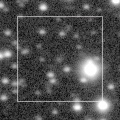
|
Now it is 17.4 mag (Apr. 1, ATLAS Chile). It stays 18 mag for a while. It stays observable in good condition.
Date(TT) R.A. (2000) Decl. Delta r Elong. m1 Best Time(A, h)
Apr. 19 17 9.16 -24 52.3 6.064 6.758 130 17.7 3:22 ( 0, 30)
Apr. 26 17 4.64 -24 16.6 5.960 6.744 138 17.7 2:50 ( 0, 31)
|

|
Now it is 17.8 mag (Mar. 27, ATLAS-MLO, Mauna Loa). It stays 18 mag for a while. In the Northern Hemisphere, it stays observable in good condition. In the Southern Hemisphere, it is not observable now, but it will appear in August.
Date(TT) R.A. (2000) Decl. Delta r Elong. m1 Best Time(A, h)
Apr. 19 19 16.89 58 5.6 5.130 5.134 84 17.8 3:53 (207, 62)
Apr. 26 19 8.04 59 23.1 5.088 5.127 86 17.7 3:43 (200, 63)
|

|
Now it is 17.9 mag (Apr. 7, Ken-ichi Kadota). It stays 18 mag for a while. In the Northern Hemisphere, it will be getting lower gradually. In the Southern Hemisphere, it will never be observable after this.
Date(TT) R.A. (2000) Decl. Delta r Elong. m1 Best Time(A, h)
Apr. 19 7 44.43 58 31.2 5.527 5.447 80 17.8 20:05 (148, 58)
Apr. 26 7 49.73 57 16.6 5.618 5.455 75 17.8 20:13 (142, 55)
|

|
Now it is 18.5 mag (Apr. 1, Jean-Francois Soulier). It stays 18 mag for a while. It stays observable in good condition.
Date(TT) R.A. (2000) Decl. Delta r Elong. m1 Best Time(A, h)
Apr. 19 17 7.04 15 11.0 4.916 5.541 123 17.9 3:19 ( 0, 70)
Apr. 26 17 6.40 15 43.5 4.836 5.516 128 17.8 2:51 ( 0, 71)
|

|
Now it is 17.2 mag (Mar. 29, ATLAS South Africa). Fading slowly. It stays extremely low in the Northern Hemisphere. In the Southern Hemisphere, it will be getting lower gradually.
Date(TT) R.A. (2000) Decl. Delta r Elong. m1 Best Time(A, h)
Apr. 19 6 8.93 -22 57.2 4.989 4.784 72 17.9 20:05 ( 52, 11)
Apr. 26 6 9.80 -21 50.8 5.125 4.835 67 18.0 20:13 ( 58, 6)
|
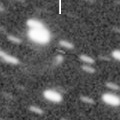
|
Now it is 17.8 mag (Apr. 7, W. Hasubick). It stays 18 mag for a while. It stays observable in good condition.
Date(TT) R.A. (2000) Decl. Delta r Elong. m1 Best Time(A, h)
Apr. 19 19 39.70 15 19.4 5.201 5.278 88 17.9 3:53 (299, 57)
Apr. 26 19 36.49 15 33.5 5.127 5.312 95 17.9 3:43 (305, 61)
|

|
It approached to Sun down to 0.11 a.u. on Mar. 9. It will fade out rapidly after this. It stays observable in good condition.
Date(TT) R.A. (2000) Decl. Delta r Elong. m1 Best Time(A, h)
Apr. 19 8 14.83 6 50.1 0.392 1.112 95 18.4 20:05 ( 43, 54)
Apr. 26 9 11.98 6 15.5 0.534 1.238 102 18.9 20:13 ( 36, 56)
|
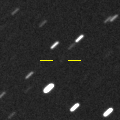
|
It became much fainter than predicted after the perihelion passage. Now it is 20.0 mag (Mar. 12, Taras Prystavski). Fading slowly. It stays observable in good condition.
Date(TT) R.A. (2000) Decl. Delta r Elong. m1 Best Time(A, h)
Apr. 19 19 59.98 -10 16.6 1.925 2.154 88 19.5 3:53 (317, 34)
Apr. 26 20 8.66 -9 19.7 1.866 2.170 93 19.6 3:43 (319, 36)
|
|
![]()
 C/2024 G3 ( ATLAS )
C/2024 G3 ( ATLAS ) C/2023 A3 ( Tsuchinshan-ATLAS )
C/2023 A3 ( Tsuchinshan-ATLAS ) 217P/LINEAR
217P/LINEAR 29P/Schwassmann-Wachmann 1
29P/Schwassmann-Wachmann 1 C/2021 G2 ( ATLAS )
C/2021 G2 ( ATLAS ) 49P/Arend-Rigaux
49P/Arend-Rigaux 48P/Johnson
48P/Johnson C/2022 N2 ( PanSTARRS )
C/2022 N2 ( PanSTARRS ) C/2022 E2 ( ATLAS )
C/2022 E2 ( ATLAS ) C/2022 QE78 ( ATLAS )
C/2022 QE78 ( ATLAS ) C/2024 L5 ( ATLAS )
C/2024 L5 ( ATLAS ) C/2024 J2 ( Wierzchos )
C/2024 J2 ( Wierzchos ) C/2023 C2 ( ATLAS )
C/2023 C2 ( ATLAS ) P/2023 S1 ( PanSTARRS )
P/2023 S1 ( PanSTARRS ) C/2014 UN271 ( Bernardinelli-Bernstein )
C/2014 UN271 ( Bernardinelli-Bernstein ) C/2023 T3 ( Fuls )
C/2023 T3 ( Fuls ) 43P/Wolf-Harrington
43P/Wolf-Harrington 496P/2024 S3 ( Hill )
496P/2024 S3 ( Hill ) (3200) Phaethon
(3200) Phaethon 65P/Gunn
65P/Gunn C/2023 R1 ( PanSTARRS )
C/2023 R1 ( PanSTARRS ) C/2023 F3 ( ATLAS )
C/2023 F3 ( ATLAS ) C/2023 H5 ( Lemmon )
C/2023 H5 ( Lemmon ) C/2024 J3 ( ATLAS )
C/2024 J3 ( ATLAS ) C/2024 E1 ( Wierzchos )
C/2024 E1 ( Wierzchos ) C/2024 A1 ( ATLAS )
C/2024 A1 ( ATLAS ) C/2022 R6 ( PanSTARRS )
C/2022 R6 ( PanSTARRS ) C/2023 Q1 ( PanSTARRS )
C/2023 Q1 ( PanSTARRS ) C/2019 U5 ( PanSTARRS )
C/2019 U5 ( PanSTARRS ) 13P/Olbers
13P/Olbers C/2017 K2 ( PanSTARRS )
C/2017 K2 ( PanSTARRS ) C/2020 V2 ( ZTF )
C/2020 V2 ( ZTF ) 47P/Ashbrook-Jackson
47P/Ashbrook-Jackson C/2021 S3 ( PanSTARRS )
C/2021 S3 ( PanSTARRS ) C/2019 L3 ( ATLAS )
C/2019 L3 ( ATLAS ) C/2019 E3 ( ATLAS )
C/2019 E3 ( ATLAS ) C/2020 K1 ( PanSTARRS )
C/2020 K1 ( PanSTARRS ) C/2024 G2 ( ATLAS )
C/2024 G2 ( ATLAS ) 472P/2023 RL75 ( NEAT-LINEAR )
472P/2023 RL75 ( NEAT-LINEAR ) C/2024 B1 ( Lemmon )
C/2024 B1 ( Lemmon ) 12P/Pons-Brooks
12P/Pons-Brooks 195P/Hill
195P/Hill 88P/Howell
88P/Howell C/2024 X2 ( ATLAS )
C/2024 X2 ( ATLAS ) (308607) 2005 WY3
(308607) 2005 WY3 362P/(457175) 2008 GO98
362P/(457175) 2008 GO98 499P/2025 A5 ( Catalina )
499P/2025 A5 ( Catalina ) 302P/Lemmon-PanSTARRS
302P/Lemmon-PanSTARRS C/2024 G6 ( ATLAS )
C/2024 G6 ( ATLAS ) C/2023 V1 ( Lemmon )
C/2023 V1 ( Lemmon ) C/2024 N4 ( Sarneczky )
C/2024 N4 ( Sarneczky ) C/2024 G4 ( PanSTARRS )
C/2024 G4 ( PanSTARRS ) C/2022 L2 ( ATLAS )
C/2022 L2 ( ATLAS ) C/2022 U1 ( Leonard )
C/2022 U1 ( Leonard ) (431760) 2008 HE
(431760) 2008 HE 105P/Singer Brewster
105P/Singer Brewster![]()






















































